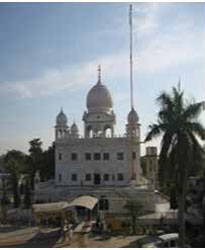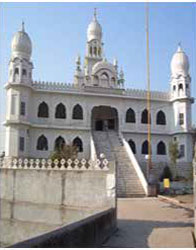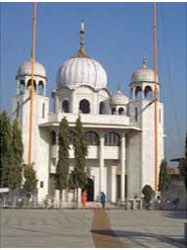Never before, has any teenager warrior, displayed a cool courage in the face of death. Their heroic deeds against tyranny are remembered every year by grateful devotees. They assemble in thousands at Chamkaur Sahib to attend the Shahidi Jormela in the memory of the two Sahibzadas. There are five historical Gurdwaras at Chamkaur. Gurdwara Garhi Sahib, stands at a place, where once stood a haveli of one Chaudhri Garibu. This was converted into a fortress by Guruji to face the larger Mughal hostile force. Another Gurdwara is Tarhi Sahib. Here the Tenth Master left the Garhi along with his three devoted Sikhs at dead of night. The place where they clapped hands to announce the departure of the Guru, a memorial called ‘Tarhi Sahib’, has been raised. Gurdwara ‘Qatalgarh Sahib’ commemorates the martyrdom of the Guru’s two elder sons, Ajit Singh and Jujhar Singh, who displayed supreme valour and heroism and became martyrs while fighting against formidable odds.
Other Gurdwaras at Chamkaur Sahib
Gurudwara Qatalgarh Sahib (Shahid Ganj), west of Garhi Sahib, is the main shrine at Chamkaur Sahib. This marks the site where the thickest hand to hand fight took place on 7 December 1705 between the Mughal army and the Sikhs, including the Sahibzadas, Ajit Singh and Jujhar Singh, and three of the original Gurdwara Bhatha Sahib Ropar Gurdwara Patalpuri Kiratpur Gurdwara Shaheed Ganj Chamkaur Sahib Gurdwara Sheshmahal Kiratpur five Piare (the Five Beloved). A Gurdwara was constructed here by Sardar Hardial Singh of Bela in 1831 but that building was replaced during the 1960’s by a new complex raised under the supervision of Sant Piara Singh of Jhar Sahib and later on Sant Bishan Singh of Amritsar. The main building called Manji Sahib is an elegant three storied domed structure standing upon a high base. The large divan hall contains an eight metre square sanctum. Another vast hall close by is called Akal Bunga. It was used for the daily congregations before Manji Sahib was constructed. To the west of Akal Bunga is an old Baoli Sahib is still in use. The Guru ka Langar, community kitchen, is further north from Baoli Sahib and Akal Bunga. The Gurdwara also houses the offices of the local managing committee which administers all historical shrines at Chamkaur under the overall control of the Shiromani Gurdwara Parbandhak Committee. In addition to the daily services, largely attended assemblies take place on the first of each Bikrami month and on important anniversaries on Sikh calendar. A three day fair called Shahidi Jor Mela is held on 6, 7 and 8 Poh, usually corresponding with 20th, 21st and 22nd December, commemorating the martyrs of Chamkaur.



